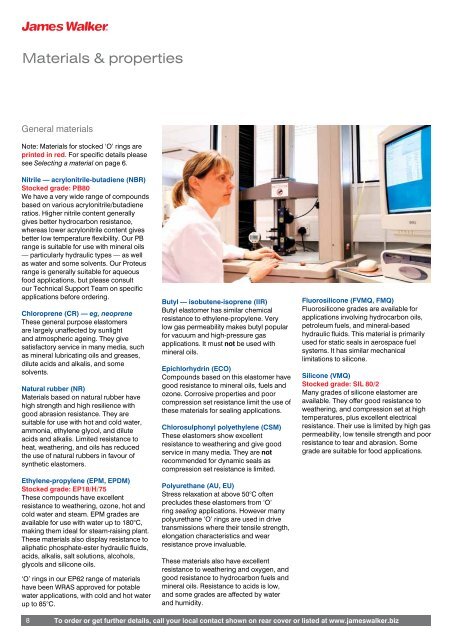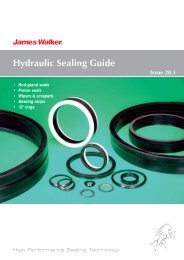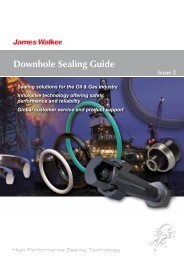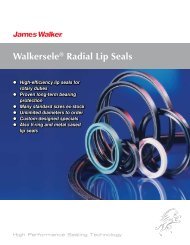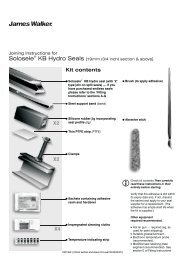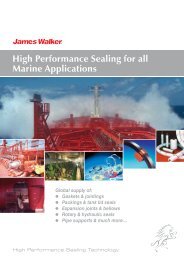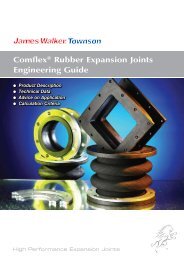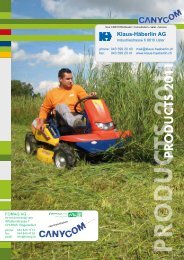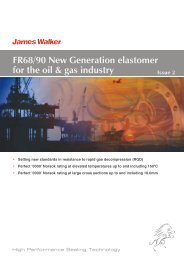'O' Ring Guide
'O' Ring Guide
'O' Ring Guide
Create successful ePaper yourself
Turn your PDF publications into a flip-book with our unique Google optimized e-Paper software.
Materials & properties<br />
General materials<br />
Note: Materials for stocked ‘O’ rings are<br />
printed in red. For specific details please<br />
see Selecting a material on page 6.<br />
Nitrile — acrylonitrile-butadiene (NBR)<br />
Stocked grade: PB80<br />
We have a very wide range of compounds<br />
based on various acrylonitrile/butadiene<br />
ratios. Higher nitrile content generally<br />
gives better hydrocarbon resistance,<br />
whereas lower acrylonitrile content gives<br />
better low temperature flexibility. Our PB<br />
range is suitable for use with mineral oils<br />
— particularly hydraulic types — as well<br />
as water and some solvents. Our Proteus<br />
range is generally suitable for aqueous<br />
food applications, but please consult<br />
our Technical Support Team on specific<br />
applications before ordering.<br />
Chloroprene (CR) — eg, neoprene<br />
These general purpose elastomers<br />
are largely unaffected by sunlight<br />
and atmospheric ageing. They give<br />
satisfactory service in many media, such<br />
as mineral lubricating oils and greases,<br />
dilute acids and alkalis, and some<br />
solvents.<br />
Natural rubber (NR)<br />
Materials based on natural rubber have<br />
high strength and high resilience with<br />
good abrasion resistance. They are<br />
suitable for use with hot and cold water,<br />
ammonia, ethylene glycol, and dilute<br />
acids and alkalis. Limited resistance to<br />
heat, weathering, and oils has reduced<br />
the use of natural rubbers in favour of<br />
synthetic elastomers.<br />
Ethylene-propylene (EPM, EPDM)<br />
Stocked grade: EP18/H/75<br />
These compounds have excellent<br />
resistance to weathering, ozone, hot and<br />
cold water and steam. EPM grades are<br />
available for use with water up to 180°C,<br />
making them ideal for steam-raising plant.<br />
These materials also display resistance to<br />
aliphatic phosphate-ester hydraulic fluids,<br />
acids, alkalis, salt solutions, alcohols,<br />
glycols and silicone oils.<br />
‘O’ rings in our EP62 range of materials<br />
have been WRAS approved for potable<br />
water applications, with cold and hot water<br />
up to 85°C.<br />
Butyl — isobutene-isoprene (IIR)<br />
Butyl elastomer has similar chemical<br />
resistance to ethylene-propylene. Very<br />
low gas permeability makes butyl popular<br />
for vacuum and high-pressure gas<br />
applications. It must not be used with<br />
mineral oils.<br />
Epichlorhydrin (ECO)<br />
Compounds based on this elastomer have<br />
good resistance to mineral oils, fuels and<br />
ozone. Corrosive properties and poor<br />
compression set resistance limit the use of<br />
these materials for sealing applications.<br />
Chlorosulphonyl polyethylene (CSM)<br />
These elastomers show excellent<br />
resistance to weathering and give good<br />
service in many media. They are not<br />
recommended for dynamic seals as<br />
compression set resistance is limited.<br />
Polyurethane (AU, EU)<br />
Stress relaxation at above 50°C often<br />
precludes these elastomers from ‘O’<br />
ring sealing applications. However many<br />
polyurethane ‘O’ rings are used in drive<br />
transmissions where their tensile strength,<br />
elongation characteristics and wear<br />
resistance prove invaluable.<br />
These materials also have excellent<br />
resistance to weathering and oxygen, and<br />
good resistance to hydrocarbon fuels and<br />
mineral oils. Resistance to acids is low,<br />
and some grades are affected by water<br />
and humidity.<br />
Fluorosilicone (FVMQ, FMQ)<br />
Fluorosilicone grades are available for<br />
applications involving hydrocarbon oils,<br />
petroleum fuels, and mineral-based<br />
hydraulic fluids. This material is primarily<br />
used for static seals in aerospace fuel<br />
systems. It has similar mechanical<br />
limitations to silicone.<br />
Silicone (VMQ)<br />
Stocked grade: SIL 80/2<br />
Many grades of silicone elastomer are<br />
available. They offer good resistance to<br />
weathering, and compression set at high<br />
temperatures, plus excellent electrical<br />
resistance. Their use is limited by high gas<br />
permeability, low tensile strength and poor<br />
resistance to tear and abrasion. Some<br />
grade are suitable for food applications.<br />
8<br />
To order or get further details, call your local contact shown on rear cover or listed at www.jameswalker.biz


